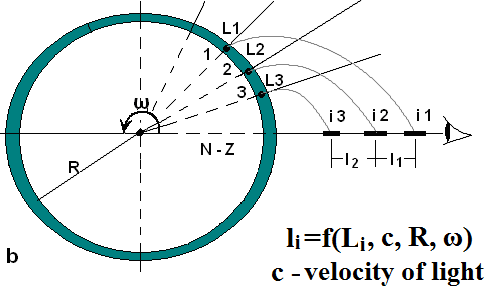The atomic kernels or particle are emitting in portions, but since in stars and «neutron stars» of atomic kernels are emitting a huge number of electromagnetic waves, and their density is high, and the time of emission is different, the radiation from all these cores and the particles coalesce into a single beam. At a short distance from the «neutron star» (or stars), the difference in the angles of radiation is not too big, and the difference between the beams is not significant. But at large distances, the radiation from various point sources are separated. Thus, when the angle between the rays is 10-12 degrees, the distance between them on the surface of a «neutron star», with a radius of 10 km, will be equal to the distance between the three atoms of a solid material. At the distance of the Earth’s radius from the center of a «neutron star», the discrepancy between these rays will be 10-10 km, which for the perception of the eye (in the case of light emission) is not discernible. At a distance of 250 light-years the difference will be 41.28 km and at a distance of 1000 light years, this discrepancy will be 165.122 km.
If a «neutron star» of the same radius as the Earth, at an angle of 10-15 degrees on the surface, the difference between the beams will be commensurate with the distance between two atoms in a solid body — 10-13 km at a distance of 250 St. years. This discrepancy will be 41 meters, and at a distance of 1000 St. Years — 165 meters.
This means that the devices record only a small part of the radiation from the «neutron stars», and it’s impossible to give an objective response by these records.
In the «neutron star» and on its surface complex physical processes taking place, that must be analyzed by specialists in nuclear physics, thermal physics, mathematics, and possibly other professionals.
The parameters of radiation, fixed on the Earth are influenced by of the rotation of the «neutron star», and the movement of the molten mass inside, and on its surface. But this whole process should have some general pattern of declining activity. Let’s look on the mechanism of radiation from the surface of a «neutron star» in moment of rotation.
(160)

(161)
(160) (161) Illustration №R-9.10.
Illustration № R-9.10 shows the mechanism of radiation of electromagnetic signals in moment of rotation of the «neutron star».
Points 1,2,3 — this is the point that closest to each other on the surface of the «neutron star», emitting signals L1, L2, L3 received on Earth.
When you rotate a «neutron star», these points, in each one’s turn cross the line N-Z observer, there is a small gap between the points which emit signals, which at close range from a «neutron star» is not visible, because the signals are merged with signals from other points (or segments), and the distance between the points 1, 2 and 3 on the surface is not significant.
When you become distant from a «neutron star» (Illustration № R-9.9) the distance between rays increases, as we see from the illustration № R-9.10, the points 1.2 and 3 alternately cross the line N-Z. Consequently, along the lines of N-Z, the first to go is the signal from the first point, second point from the second and third — from the third point.
The duration of signals and pauses between these signals depend on the speed of rotation of the «neutron star» and on its radius.
τi = f(Rnz; ωnz; β)
where, τi — time of radiation;
Rnz — radius of the «neutron star»;
ωnz — speed of the «neutron star» rotation;
β — the angle of beam expansion, for an observer.
τp = f(Rnz; Wnz; α)
where, τp — the time between the signals
α — the angle between the points (1, 2, 3), emitting signals.

Graphical, signal coming from the object can be visualized.

(162) Graph №G–9.1
On graph № G-9.1, the signal from the «neutron star» should be recorded as on time and on power.
In the case when only the speed of rotation of the «neutron star» reduces, should be increased – time of radiation and time of breaks, other parameters should remain the same.

(163) Graph №G–9.2


